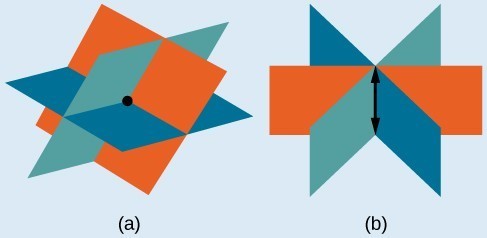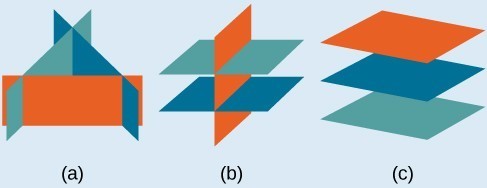Solve Systems of Three Equations in Three Variables
Learning Objectives
- Determine whether an ordered triple is a solution to a system of three equations
- Use back substitution to find a solution to a system of three equations
- Write the equations for a system given a scenario, and solve
- Interchange the order of any two equations.
- Multiply both sides of an equation by a nonzero constant.
- Add a nonzero multiple of one equation to another equation.
A General Note: Number of Possible Solutions
The planes illustrate possible solution scenarios for three-by-three systems.- Systems that have a single solution are those which, after elimination, result in a solution set consisting of an ordered triple [latex]\left\{\left(x,y,z\right)\right\}[/latex]. Graphically, the ordered triple defines a point that is the intersection of three planes in space.
- Systems that have an infinite number of solutions are those which, after elimination, result in an expression that is always true, such as [latex]0=0[/latex]. Graphically, an infinite number of solutions represents a line or coincident plane that serves as the intersection of three planes in space.
- Systems that have no solution are those that, after elimination, result in a statement that is a contradiction, such as [latex]3=0[/latex]. Graphically, a system with no solution is represented by three planes with no point in common.
 (a)Three planes intersect at a single point, representing a three-by-three system with a single solution. (b) Three planes intersect in a line, representing a three-by-three system with infinite solutions.
(a)Three planes intersect at a single point, representing a three-by-three system with a single solution. (b) Three planes intersect in a line, representing a three-by-three system with infinite solutions.
Example: Determining Whether an Ordered Triple Is a Solution to a System
Determine whether the ordered triple [latex]\left(3,-2,1\right)[/latex] is a solution to the system.[latex]\begin{array}{l}\text{ }x+y+z=2\hfill \\ 6x - 4y+5z=31\hfill \\ 5x+2y+2z=13\hfill \end{array}[/latex]
Answer: We will check each equation by substituting in the values of the ordered triple for [latex]x,y[/latex], and [latex]z[/latex].
[latex]\begin{array}{ccccc}\begin{array}{r}\hfill x+y+z=2\\ \hfill \left(3\right)+\left(-2\right)+\left(1\right)=2\\ \hfill \text{True}\end{array}& & \begin{array}{r}\hfill \text{}6x - 4y+5z=31\\ \hfill 6\left(3\right)-4\left(-2\right)+5\left(1\right)=31\\ \hfill 18+8+5=31\\ \hfill \text{True}\end{array}& & \begin{array}{r}\hfill \text{}5x+2y+2z=13\\ \hfill 5\left(3\right)+2\left(-2\right)+2\left(1\right)=13\\ \hfill \text{}15 - 4+2=13\\ \hfill \text{True}\end{array}\end{array}[/latex]
The ordered triple [latex]\left(3,-2,1\right)[/latex] is indeed a solution to the system.How To: Given a linear system of three equations, solve for three unknowns.
- Pick any pair of equations and solve for one variable.
- Pick another pair of equations and solve for the same variable.
- You have created a system of two equations in two unknowns. Solve the resulting two-by-two system.
- Back-substitute known variables into any one of the original equations and solve for the missing variable.
Example: Solving a System of Three Equations in Three Variables by Elimination
Find a solution to the following system:[latex]\begin{array}{ll}\text{ }x - 2y+3z=9\hfill & \text{(1)}\hfill \\ \text{ }-x+3y-z=-6\hfill & \text{(2)}\hfill \\ 2x - 5y+5z=17\hfill & \text{(3)}\hfill \end{array}[/latex]
Answer: There will always be several choices as to where to begin, but the most obvious first step here is to eliminate [latex]x[/latex] by adding equations (1) and (2).
[latex]\frac{\begin{array}{ll}\text{ }\text{}x - 2y+3z=9\hfill & \text{(1)}\hfill \\ \text{ }-x+3y-z=-6\hfill & \text{ (2)}\hfill \end{array}}{\begin{array}{ll}\text{ }\text{}\text{}y+2z=3\hfill & \text{ (3)}\hfill \end{array}}[/latex]
The second step is multiplying equation (1) by [latex]-2[/latex] and adding the result to equation (3). These two steps will eliminate the variable [latex]x[/latex].[latex]\begin{array} \hfill−2x+4y−6z=−18 \hfill& \left(1\right)\text{ multiplied by }−2 \\ 2x−5y+5z=17 \hfill& \left(3\right) \\ \text{_____________________________} \\ \hfill−y−z=−1\left(5\right)\hfill& \end{array}[/latex]
In equations (4) and (5), we have created a new two-by-two system. We can solve for [latex]z[/latex] by adding the two equations.[latex]\frac{\begin{array}{l}\begin{array}{l}\hfill \\ \text{}y+2z=3\text{ }\left(4\right)\hfill \end{array}\hfill \\ -y-z=-1\text{ }\left(5\right)\hfill \end{array}}{z=2\text{ }\left(6\right)}[/latex]
Choosing one equation from each new system, we obtain the upper triangular form:[latex]\begin{array}{ll}\text{}\text{}x - 2y+3z=9\text{ }\hfill & \left(1\right)\hfill \\ \text{ }y+2z=3\hfill & \left(4\right)\hfill \\ \text{ }z=2\hfill & \left(6\right)\hfill \end{array}[/latex]
Next, we back-substitute [latex]z=2[/latex] into equation (4) and solve for [latex]y[/latex].[latex]\begin{array}{l}y+2\left(2\right)=3\hfill \\ \text{ }y+4=3\hfill \\ \text{ }y=-1\hfill \end{array}[/latex]
Finally, we can back-substitute [latex]z=2[/latex] and [latex]y=-1[/latex] into equation (1). This will yield the solution for [latex]x[/latex].[latex]\begin{array}{r}\hfill x - 2\left(-1\right)+3\left(2\right)=9\\ \hfill \text{ }x+2+6=9\\ \hfill \text{ }x=1\end{array}[/latex]
The solution is the ordered triple [latex]\left(1,-1,2\right)[/latex].
Try It
Solve the system of equations in three variables.[latex]\begin{array}{l}2x+y - 2z=-1\hfill \\ 3x - 3y-z=5\hfill \\ x - 2y+3z=6\hfill \end{array}[/latex]
Answer: [latex]\left(1,-1,1\right)[/latex]
Example: Solving a Real-World Problem Using a System of Three Equations in Three Variables
In the problem posed at the beginning of the section, John invested his inheritance of $12,000 in three different funds: part in a money-market fund paying 3% interest annually; part in municipal bonds paying 4% annually; and the rest in mutual funds paying 7% annually. John invested $4,000 more in mutual funds than he invested in municipal bonds. The total interest earned in one year was $670. How much did he invest in each type of fund?Answer: To solve this problem, we use all of the information given and set up three equations. First, we assign a variable to each of the three investment amounts:
[latex]\begin{array}{l}x=\text{amount invested in money-market fund}\hfill \\ y=\text{amount invested in municipal bonds}\hfill \\ z=\text{amount invested in mutual funds}\hfill \end{array}[/latex]
The first equation indicates that the sum of the three principal amounts is $12,000.[latex]x+y+z=12,000[/latex]
We form the second equation according to the information that John invested $4,000 more in mutual funds than he invested in municipal bonds.[latex]z=y+4,000[/latex]
The third equation shows that the total amount of interest earned from each fund equals $670.[latex]0.03x+0.04y+0.07z=670[/latex]
Then, we write the three equations as a system.[latex]\begin{array}{l}\text{ }x+y+z=12,000\hfill \\ \text{ }-y+z=4,000\hfill \\ 0.03x+0.04y+0.07z=670\hfill \end{array}[/latex]
To make the calculations simpler, we can multiply the third equation by 100. Thus,[latex]\begin{array}{ll}\text{ }x+\text{ }y+z\text{ }=12,000\hfill & \left(1\right)\hfill \\ \text{ }-y+z\text{ }=4,000\hfill & \left(2\right)\hfill \\ 3x+4y+7z=67,000\hfill & \left(3\right)\hfill \end{array}[/latex]
Step 1. Interchange equation (2) and equation (3) so that the two equations with three variables will line up.[latex]\begin{array}{l}\text{ }x+\text{ }y +\text{ }z=12,000\hfill \\ 3x+4y +7z=67,000\hfill \\ \text{ }-y\text{ }+\text{ }z=4,000\hfill \end{array}[/latex]
Step 2. Multiply equation (1) by [latex]-3[/latex] and add to equation (2). Write the result as row 2.[latex]\begin{array}{l}x+y+z\text{ }=12,000\hfill \\ \text{ }y+4z=31,000\hfill \\ \text{ }-y+z\text{ }=4,000\hfill \end{array}[/latex]
Step 3. Add equation (2) to equation (3) and write the result as equation (3).[latex]\begin{array}{l}x+y+\text{ }z=12,000\hfill \\ \text{ }y+4z=31,000\hfill \\ \text{ }5z\text{ }=35,000\hfill \end{array}[/latex]
Step 4. Solve for [latex]z[/latex] in equation (3). Back-substitute that value in equation (2) and solve for [latex]y[/latex]. Then, back-substitute the values for [latex]z[/latex] and [latex]y[/latex] into equation (1) and solve for [latex]x[/latex].[latex]\begin{array}{l}\text{ }5z=35,000\hfill \\ \text{ }z=7,000\hfill \\ \hfill \\ \hfill \\ \text{ }y+4\left(7,000\right)=31,000\hfill \\ \text{ }y=3,000\hfill \\ \hfill \\ \hfill \\ x+3,000+7,000=12,000\hfill \\ \text{ }x=2,000\hfill \end{array}[/latex]
John invested $2,000 in a money-market fund, $3,000 in municipal bonds, and $7,000 in mutual funds.Licenses & Attributions
CC licensed content, Original
- Revision and Adaptation. Provided by: Lumen Learning License: CC BY: Attribution.
CC licensed content, Shared previously
- College Algebra. Provided by: OpenStax Authored by: Abramson, Jay et al.. Located at: https://openstax.org/books/college-algebra/pages/1-introduction-to-prerequisites. License: CC BY: Attribution. License terms: Download for free at http://cnx.org/contents/[email protected].
- Question ID 23765. Authored by: Shahbazian,Roy. License: CC BY: Attribution. License terms: IMathAS Community License CC-BY + GPL.
- Systems of Equations in Three Variables: Part 1 of 2 . Authored by: Sousa, James (Mathispower4u.com). License: CC BY: Attribution.
